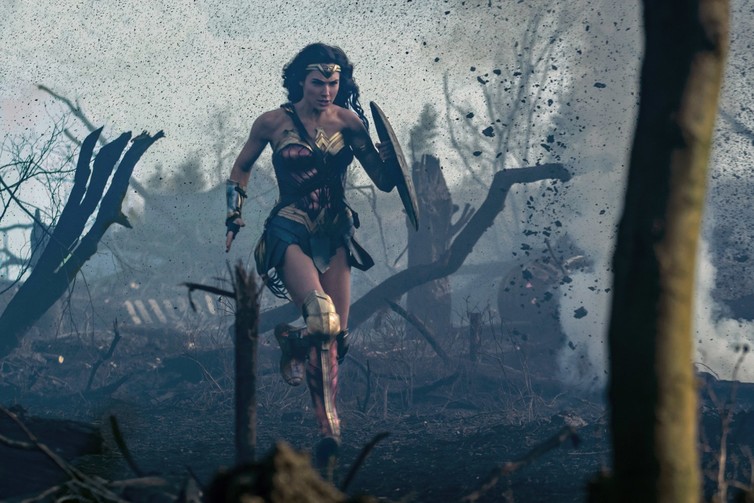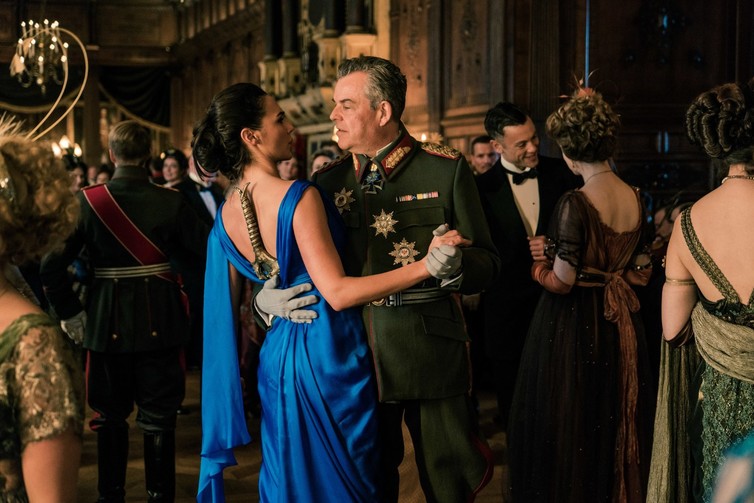
Wonder Woman is a film about a superbly violent woman who uses her physical prowess to help end “the war to end all wars”. She kills countless German soldiers – dispatching one officer in hand-to-hand combat. She helps British and American soldiers eliminate German manufacturers of poison gas. When enraged, she destroys all around her, life and property. But her aims are pacifist – she wants to bring peace to the world.
She is Diana, the Amazonian princess who is also battling the God of War. She was trained to do so by her aunt, the greatest Amazonian General Antiope. When deciding to leave her Amazonian paradise for the grim theatre of war, Diana (Gal Gadot) explains that she is compelled to do so. Mirroring the self-reflections of many men who have enlisted to fight, she wonders who she’d be if she didn’t do what she thought was right. She embodies the prodigiously masculine virtue of honour.

Yet, Diana remains supremely womanly. She cries at the death of innocents and the sight of broken male bodies returning from the battlefields of the first world war. She is drawn to babies and infants (to be fair, they are rare in the female-only Themyscira, her place of origin). She appoints herself protector of displaced women and children. So immense is her capacity for empathy that she unlocks a year-long, gridlocked frontline for the male soldiers behind her.
This is a paragon of femininity whose acts of violence are guided by masculine codes of honour. But what of “ordinary” women in England in the 1910s – the place and time in which the movie is set – who performed acts of violence?
Honour, violence and women
Historically, violence has not been seen as a feminine activity. Women were regarded as the sex that was more passive, submissive, and sensitive to others. Those who committed particularly violent acts tended to be labelled masculine at best, abhorrent at worst.
Men were permitted to use violence against other men in the name of honour. Honour meant courage, chivalry, honesty, and fairness. Honour codes were backed by the threat of violence.

Women were not permitted to assume an active relationship with honour and its codes. Instead, a passive role was conferred on them through the notion of chivalry – a benevolent form of sexism whereby the strong, active sex protects the weaker, passive one.
England in the 1910s was home to notorious acts of female violence. Suffragettes – members of the Women’s Social and Political Union – performed a range of militant activities in the campaign for the vote: breaking windows, fire-bombing letterboxes and houses, and whipping and throwing hatchets at male politicians. These violent women challenged reigning concepts of womanhood.
Women against female violence
 Today, many women engage in violent activities. They are to be found leading insurgent groups, carrying out terror attacks, committing war crimes, hijacking planes, and abusing political prisoners. Other violent acts by women are deemed more acceptable. They are permitted, for example, to defend themselves from attack, to take part in physically aggressive sports like boxing, and to fight in the armed forces.Yet at this time, other women were the loudest and fiercest opponents of the suffragettes’ tactics. Why? These women argued that honour codes, with their emphasis on chivalry, protected women from men’s “innate” violence. Women behaving violently showed men that women did not need their chivalrous protection.
Today, many women engage in violent activities. They are to be found leading insurgent groups, carrying out terror attacks, committing war crimes, hijacking planes, and abusing political prisoners. Other violent acts by women are deemed more acceptable. They are permitted, for example, to defend themselves from attack, to take part in physically aggressive sports like boxing, and to fight in the armed forces.Yet at this time, other women were the loudest and fiercest opponents of the suffragettes’ tactics. Why? These women argued that honour codes, with their emphasis on chivalry, protected women from men’s “innate” violence. Women behaving violently showed men that women did not need their chivalrous protection.
Yet the female use of physical force is still contentious. One Russian woman, for instance, is reportedly suing sporting goods manufacturer, Nike, for an ad campaign showcasing a female boxer. She argues it promotes the idea that women are made of “bruises and punches”.
Even feminists are split on the question of female violence. Some (known as women’s values feminists) believe that women are the innately peaceful sex, charged with the task of standing up to destructive male militarism.
In contrast, equal rights feminists believe that this attitude is just a new version of the “separate spheres” ideology that has been used to oppress women for centuries.
Because of these seemingly unbridgeable beliefs, there has been a reluctance on the part of many feminists to theorise about women’s desires for power, domination and violence.
Gal Gadot’s Wonder Woman, I’d argue, does a fine job of satisfying these two competing forms of feminism. She fights better than a man (male god included). Yet she prioritises peace and love above all else. Indeed, this is what she fights for.
Sure, Wonder Woman has all the trappings of a male fantasy – a scantily-clad, stunningly attractive, woman fighter. But, this is a thinking female fighter – a violent woman who questions the ethics of her violence and that of the men around her.
In a world where public avenues for violence are increasingly open to women, this female warrior presents us with an ethical and feminist model of fighting femininity.
Sharon Crozier-De Rosa, Senior Lecturer in History, University of Wollongong
This article was originally published on The Conversation. Read the original article.




















